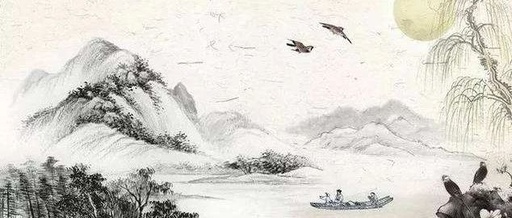
Meridian Section
In the “Lingshu: Meridians”, it states: “In acupuncture, the meridians are the beginning, guiding the flow, regulating the measurements, connecting the five internal organs internally, and differentiating the six external organs externally.” The way of acupuncture must first trace its origins, understand the beginning and end, comprehend the flow, and know the significance of the acupoints.
Initially, a person is born from essence, and when essence is generated, the brain marrow is formed. The bones serve as the support for the body, the meridians transport and distribute throughout the body, the tendons connect the bones, the flesh protects the internal organs, the skin is firm and the hair grows long. Food enters the stomach, the pathways are open, and blood and qi circulate continuously.
According to Li Shizhen in the Ming Dynasty, in “The Study of the Eight Extraordinary Meridians”: “In a person’s body, there are meridians and collaterals. The main pathways are called meridians, while the branches are called collaterals. There are twelve main meridians: three yin and three yang of the hands, and three yin and three yang of the feet.”
Below are the pathways of the twelve meridians, derived from the “Huangdi Neijing”:
“The Lung Hand Taiyin Meridian begins in the middle jiao, connects to the large intestine, returns to the stomach, ascends to the diaphragm, belongs to the lung, exits horizontally under the armpit, descends along the inner arm, travels before the heart of the Shaoyin, descends through the elbow, follows the inner arm along the lower edge of the bone to the wrist, ascends to the fish region, follows the fish border, and exits at the tip of the thumb; its branch exits from the back of the wrist directly to the inner edge of the index finger.”
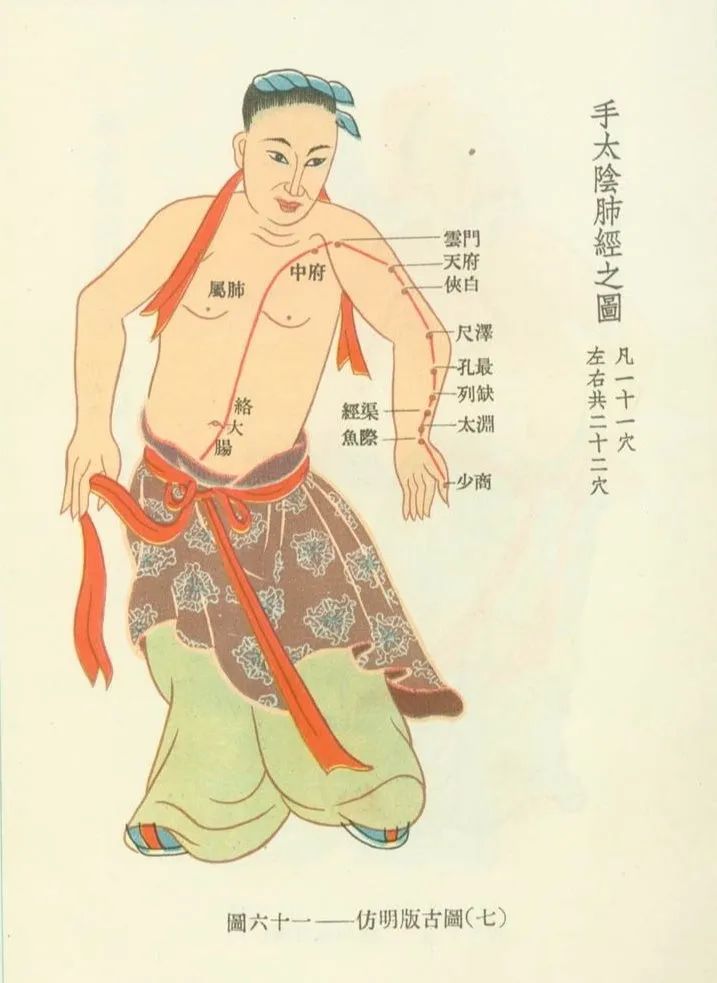
The Large Intestine Hand Yangming Meridian begins at the tip of the index finger, follows the outer edge of the finger, exits between the two bones of Hegu, ascends between the two tendons, follows the upper edge of the arm, enters the outer elbow, ascends the outer front of the shoulder, exits before the acromion, ascends to the upper part of the clavicle, descends into the supraclavicular fossa, connects to the lung and descends to the diaphragm, belongs to the large intestine. Its branch ascends from the supraclavicular fossa to the neck, penetrates the cheek, enters the lower teeth, exits at the corner of the mouth, crosses the philtrum, and ascends to the nostrils.”
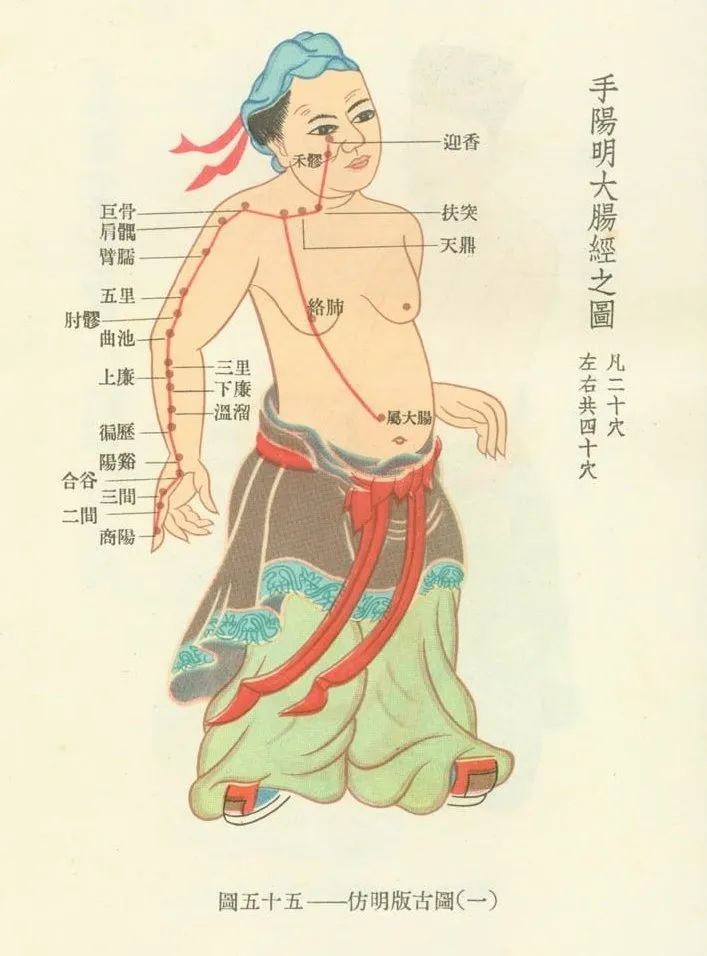
The Stomach Foot Yangming Meridian begins at the intersection of the nose, receives the Taiyang Meridian, descends along the outer nose, enters the upper teeth, exits at the corner of the mouth, encircles the lips, descends to Chengjiang, follows the jawline, exits at Daying, follows the cheek, ascends in front of the ear, passes through the temple, follows the hairline, reaches the forehead; its branch descends from Daying to Renying, follows the throat, enters the supraclavicular fossa, descends to the diaphragm, belongs to the stomach, connects to the spleen; its direct pathway descends from the supraclavicular fossa to the inner side of the breast, descends along the side of the navel, enters the qi street; its branch begins at the stomach, descends through the abdomen, reaches the qi street, descends through the hip joint, reaches the knee, descends along the outer edge of the tibia, enters between the middle toes; its branch descends three inches and separates, entering between the second toe; its branch separates at the ankle, entering between the big toe and exiting at its tip.”
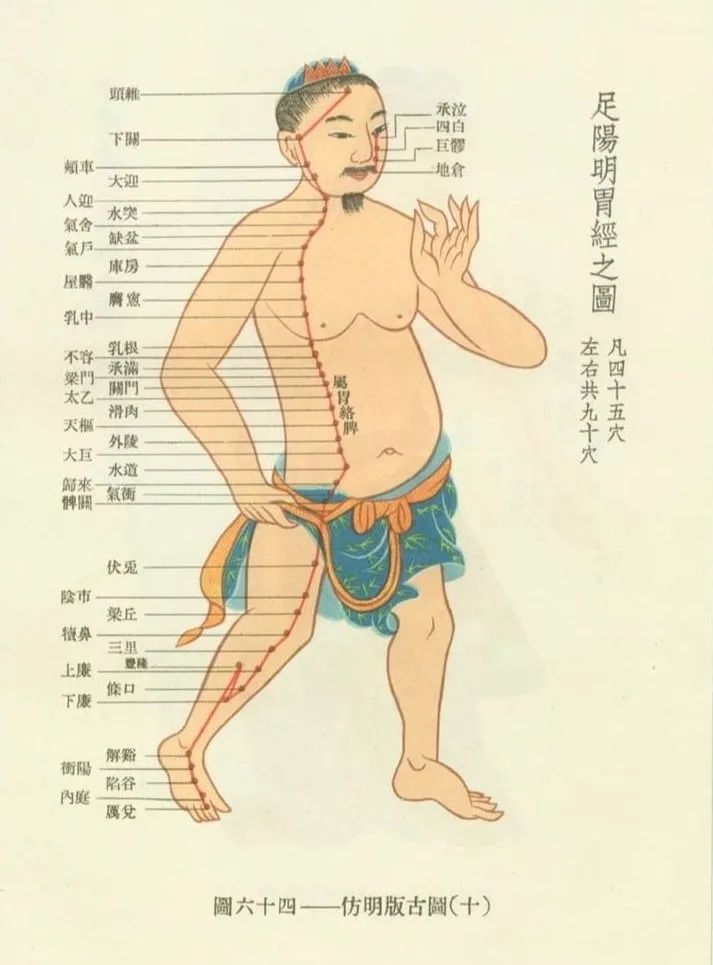
The Spleen Foot Taiyin Meridian begins at the tip of the big toe, follows the inner side of the toe, passes behind the navicular bone, ascends in front of the inner ankle, follows the inner side of the tibia, crosses in front of the knee, enters the abdomen, belongs to the spleen, connects to the stomach, ascends to the diaphragm, encircles the throat, connects to the root of the tongue, disperses under the tongue; its branch returns from the stomach, separates at the diaphragm, and enters the heart.
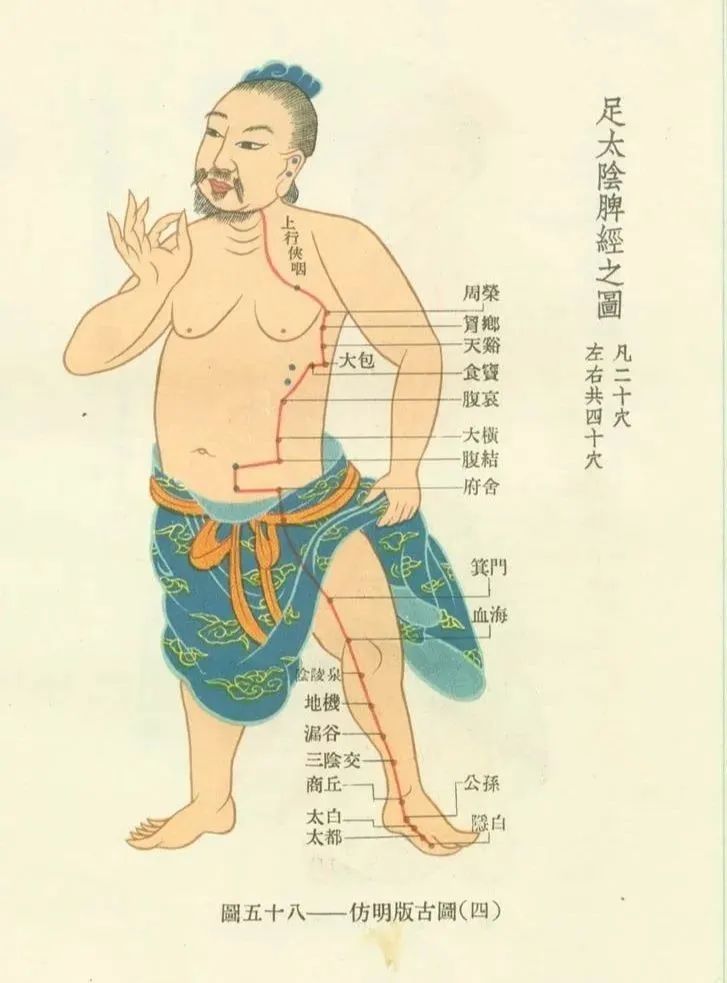
The Heart Hand Shaoyin Meridian begins at the heart, exits belonging to the heart system, descends to the diaphragm, connects to the small intestine; its branch ascends from the heart system, encircles the throat, connects to the eye system; its direct pathway returns from the heart system, ascends to the lung, descends through the armpit, follows the inner arm along the back edge, travels behind the heart of the Taiyin, descends through the inner elbow, follows the inner arm along the back edge, reaches the tip of the palm, enters the inner side of the palm, follows the little finger, and exits at its tip.
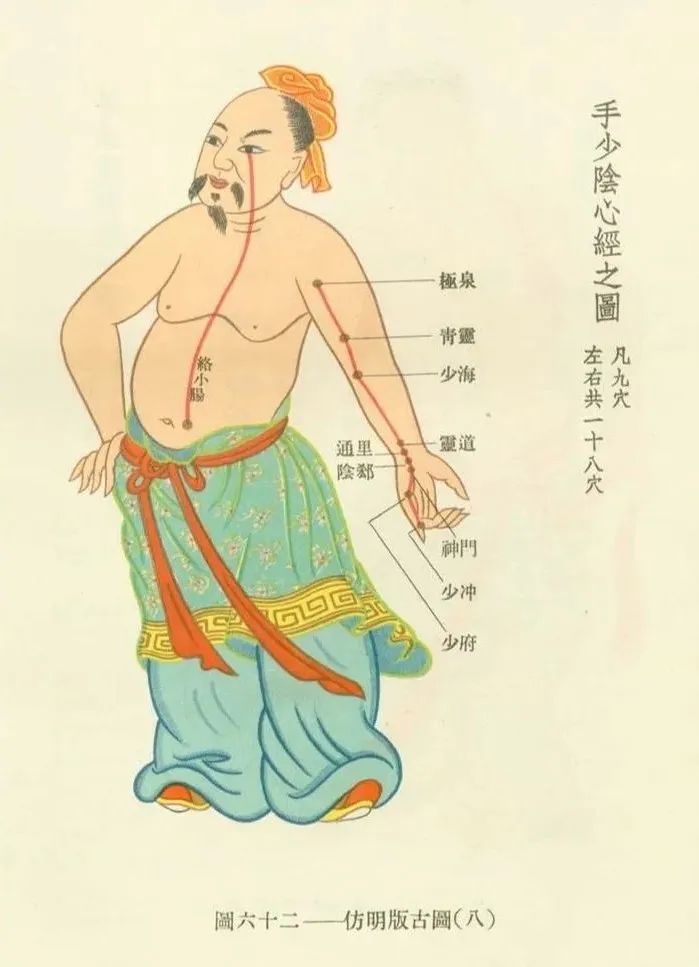
The Small Intestine Hand Taiyang Meridian begins at the tip of the little finger, follows the outer side of the hand, ascends to the wrist, exits at the middle of the ankle, directly ascends along the lower edge of the arm bone, exits between the two tendons of the inner elbow, ascends along the outer back edge of the shoulder, exits at the shoulder joint, encircles the shoulder blade, crosses the shoulder, enters the supraclavicular fossa, connects to the heart, descends to the throat, reaches the diaphragm, connects to the stomach, belongs to the small intestine; its branch ascends from the supraclavicular fossa, follows the neck to the cheek, reaches the eye corner, and enters the ear; its branch separates at the cheek, reaches the nose, and connects to the inner corner of the eye, obliquely connecting to the cheekbone.
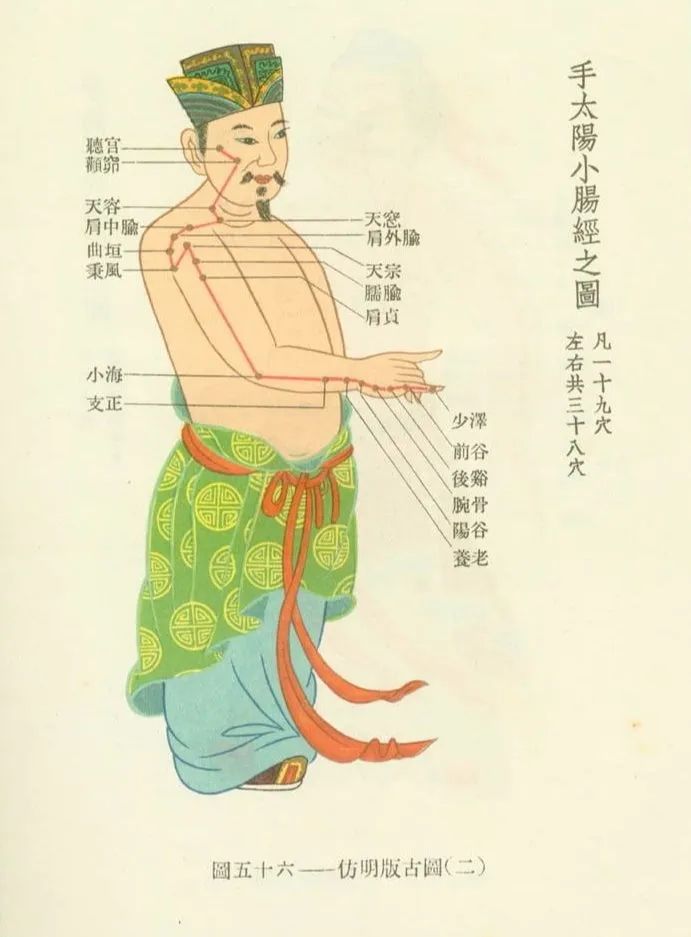
The Bladder Foot Taiyang Meridian begins at the inner corner of the eye, ascends to the forehead, its branch ascends from the forehead to the top of the head; its direct pathway enters the brain, exits at the back of the neck, follows the shoulder blade, encircles the spine, reaches the waist, enters the lumbar region, connects to the kidney, belongs to the bladder; its branch descends from the waist, follows the spine, penetrates the buttocks, enters the popliteal fossa; its branch separates from the inner thigh, descends through the hip joint, follows the outer edge, descends to the popliteal fossa; it then descends through the inner ankle, exits behind the outer ankle, follows the tibia, and reaches the outer side of the little toe.
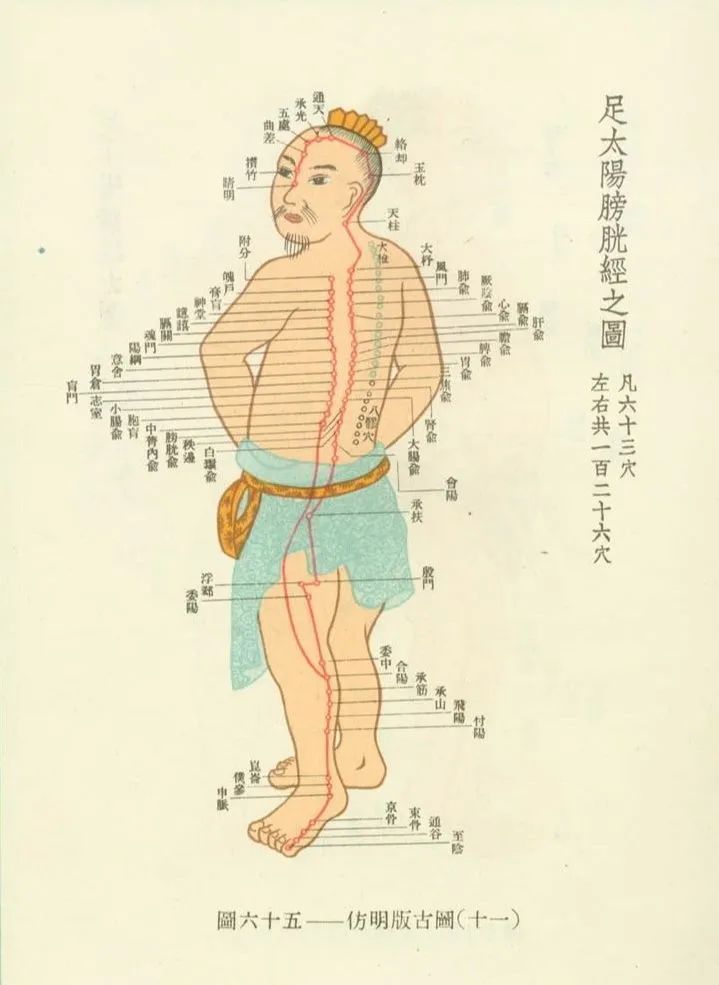
The Kidney Foot Shaoyin Meridian begins at the bottom of the little toe, travels through the sole of the foot, exits beneath the ball of the foot, follows the back of the inner ankle, separates into the heel, ascends through the inner ankle, follows the inner thigh, penetrates the spine, belongs to the kidney, connects to the bladder; its direct pathway ascends from the kidney, penetrates the liver, enters the lung, follows the throat, and connects to the root of the tongue; its branch ascends from the lung, connects to the heart, and enters the chest.
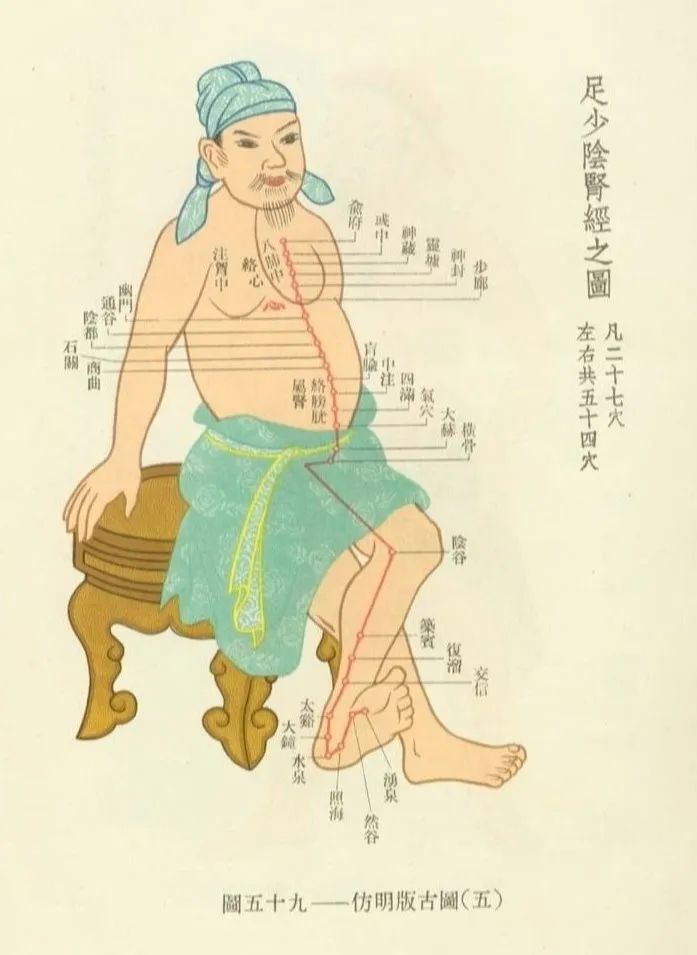
The Heart Master Hand Jueyin Meridian begins at the center of the chest, exits belonging to the pericardium, descends to the diaphragm, traverses the three jiaos; its branch follows the chest, exits the side, descends three inches under the armpit, ascends to the armpit, follows the inner arm, travels between the two tendons, enters the palm, follows the middle finger, and exits at its tip; its branch separates from the palm, follows the little finger and index finger, and exits at its tip.
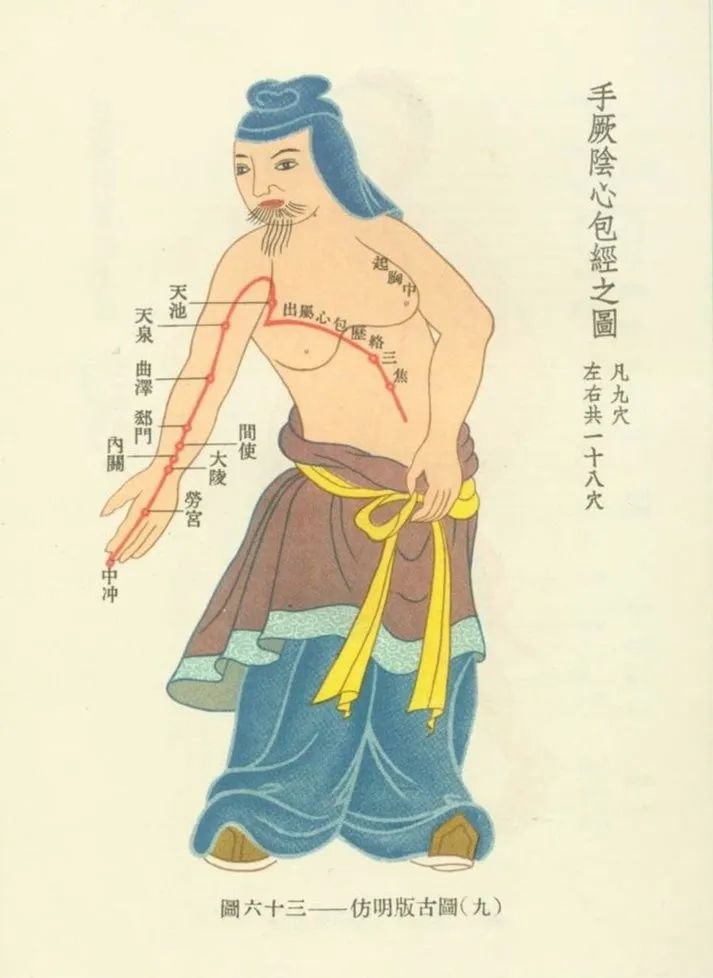
The Triple Burner Hand Shaoyang Meridian begins at the tip of the index finger, ascends between the two fingers, follows the outer wrist, exits between the two bones of the arm, ascends through the elbow, follows the outer shoulder, crosses the shoulder, enters the supraclavicular fossa, spreads in the chest, disperses the pericardium, descends to the diaphragm, and belongs to the triple burner; its branch ascends from the chest, exits the supraclavicular fossa, ascends to the back of the neck, connects to the ear, directly ascends to the top of the ear, bends down to the cheek; its branch enters the ear, exits in front of the ear, crosses the cheek, and reaches the inner corner of the eye.
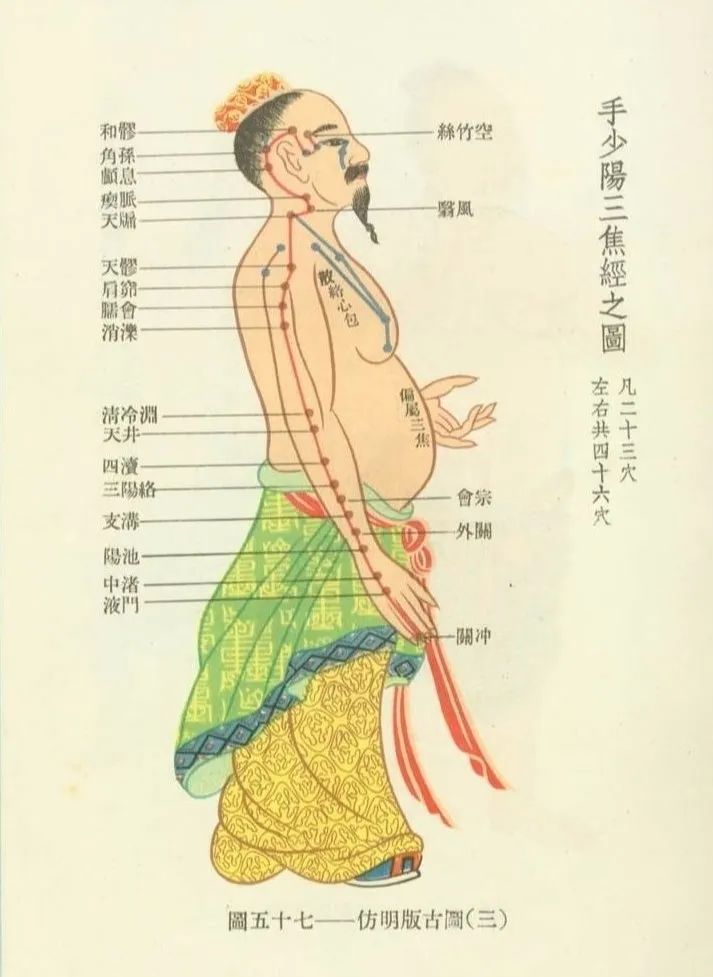
The Gallbladder Foot Shaoyang Meridian begins at the inner corner of the eye, ascends to the temple, descends behind the ear, follows the neck, travels before the hand Shaoyang, reaches the shoulder, crosses after the hand Shaoyang, enters the supraclavicular fossa; its branch enters the ear, exits in front of the ear, reaches the inner corner of the eye; its branch separates at the inner corner of the eye, descends to Daying, connects to the hand Shaoyang, reaches the cheek, descends to the neck, connects to the supraclavicular fossa, enters the chest, penetrates the diaphragm, connects to the liver, belongs to the gallbladder, follows the side of the ribs, exits the qi street, encircles the hairline, horizontally enters the hip joint; its direct pathway descends from the supraclavicular fossa to the armpit, follows the chest, passes through the lateral ribs, descends to the hip joint, follows the outer edge, descends to the outer knee, exits in front of the outer bone, directly descends to the tip of the tailbone, exits in front of the outer ankle, follows the foot, enters between the little toe and the second toe; its branch separates at the ankle, enters between the big toe, follows the inner edge of the big toe, and exits at its tip, also penetrating the nail and exiting at the three hairs.”
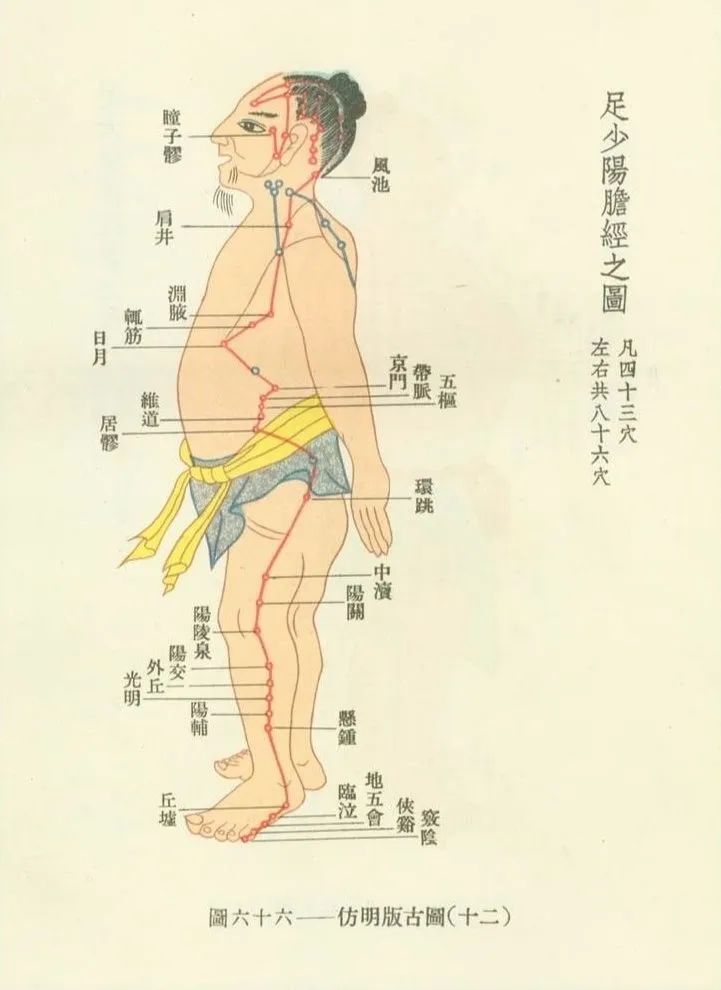
The Liver Foot Jueyin Meridian begins at the junction of the hair of the big toe, ascends along the outer edge of the foot, one inch from the inner ankle, eight inches from the ankle, crosses behind the Taiyin, ascends along the inner thigh, enters the hair, passes through the genitals, reaches the lower abdomen, encircles the stomach, belongs to the liver, connects to the gallbladder, ascends through the diaphragm, spreads in the ribs, follows the throat, ascends to the head, connects to the eye system, ascends to the forehead, and meets the Du Meridian at the top of the head; its branch descends from the eye system to the cheek, encircles the lips; its branch returns from the liver, separates, penetrates the diaphragm, and enters the lung.”“
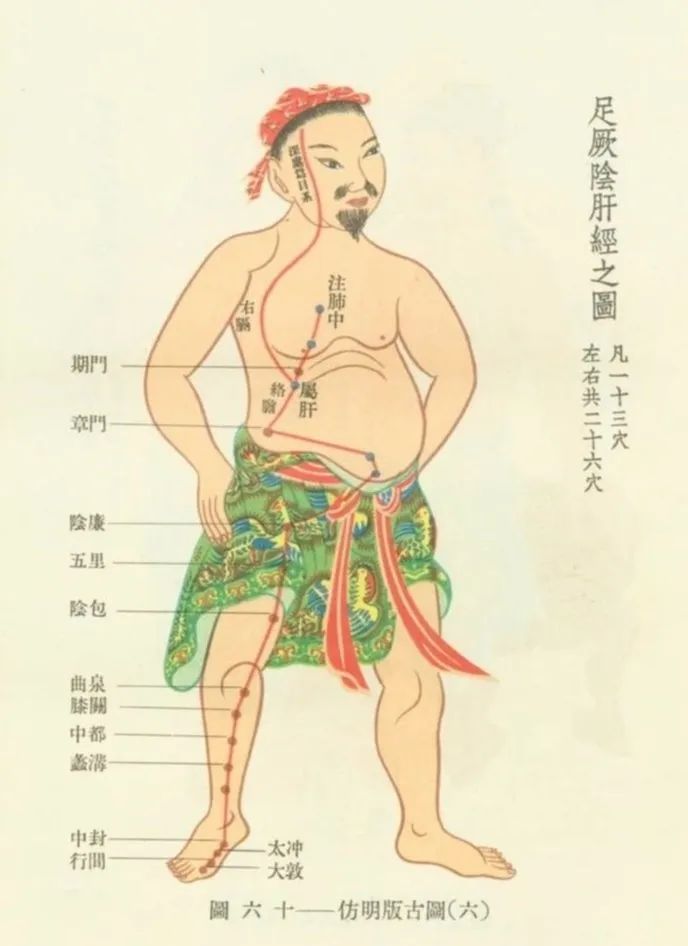
Below are the original texts and diagrams of the Ren and Du meridians:
The Ren Meridian begins below the Zhongji, ascends along the hairline, follows the abdomen, reaches the Guanyuan, ascends to the throat, follows the jaw, and enters the eyes.
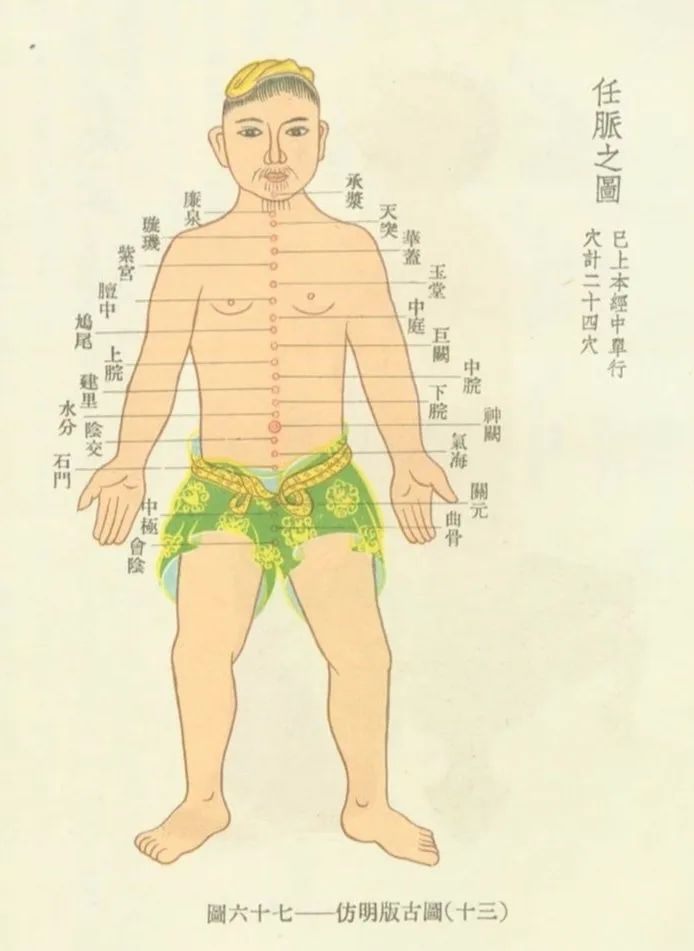
The Du Meridian begins at the center of the lower abdomen. In women, it enters the vaginal orifice, which is the end of the urinary orifice, its collateral follows the genitals, encircles the anus, separates around the buttocks, connects to the Shaoyin, and joins the Yangming at the inner thigh, penetrating the spine and belonging to the kidney. In men, it follows the penis down to the anus, similar to women. The lower abdomen directly ascends, penetrating the center, ascends to the heart, enters the throat, follows the jaw, encircles the lips, and connects to the center below the two eyes.”
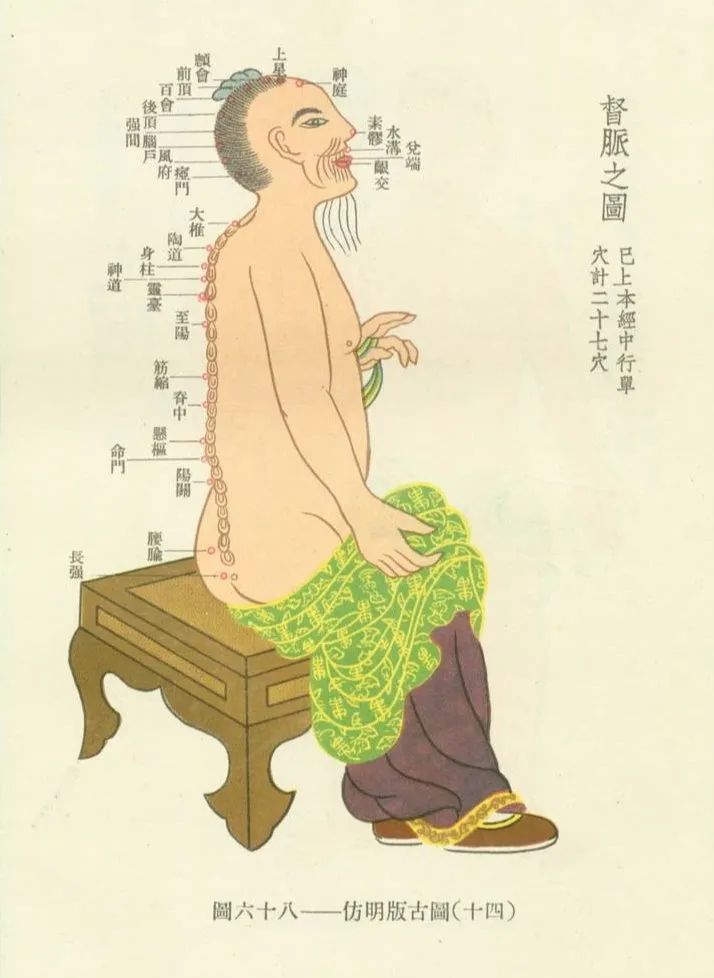
Collateral Section:
In the “Lingshu: Meridians”, it states: “The twelve meridians run deep between the flesh and are not visible; the ones that are commonly seen are the foot Taiyin above the outer ankle, which is not hidden. All the visible meridians are collaterals. The meridians are usually not visible; their fullness and emptiness can be known through the pulse. All visible pulses are collaterals.”
The twelve meridians are hidden within the body and run between the flesh, positioned deep and not easily seen. Their fullness and emptiness can be determined through pulse diagnosis. The visible ones are due to the foot Taiyin spleen meridian passing above the inner ankle, which is not concealed. Therefore, the meridians that are superficial and easily seen are collaterals.
It is also said: “All collaterals cannot pass through the major joints; they must run through the pathways that are not obstructed, and their connections are all visible externally. Therefore, when needling the collaterals, one must prick at the places where blood accumulates. Even if there is no accumulation, one should urgently prick to expel the pathogenic factors and release the blood.”
The collaterals all do not run through the major joints but flow in areas where the meridians do not reach, entering and exiting, combining with the superficial collaterals, and collectively manifesting externally.When needling the collaterals,it is necessaryto needle at the places where they gather. In severe cases, even if there is bruising on the skin, one should urgently needle to expel the pathogenic factors and release the blood.
Fifteen collaterals connect with the main meridians, nourishing qi and blood.
Thus, it is said: “The branch of the Hand Taiyin is called Liexue. When there is fullness, it causes heat in the hand; when there is emptiness, it causes cough and frequent urination. Needle it half an inch from the wrist. It also connects to Yangming.”
The branch of the Hand Shaoyin is called Tongli. When there is fullness, it causes chest oppression; when there is emptiness, it causes inability to speak. Needle it one inch behind the palm, connecting to Taiyang.”
The branch of the Hand Heart Master is called Neiguan. When there is fullness, it causes heart pain; when there is emptiness, it causes headache. Needle it between the two tendons.
The branch of the Hand Taiyang is called Zhi Zheng. When there is fullness, it causes elbow laxity; when there is emptiness, it causes warts, small like finger calluses. Needle it at the place where it branches off.
The branch of the Hand Yangming is called Pianli. When there is fullness, it causes tooth decay and deafness; when there is emptiness, it causes cold teeth and obstruction. Needle it at the place where it branches off.
The branch of the Hand Shaoyang is called Wai Guan. When there is fullness, it causes elbow spasm; when there is emptiness, it causes inability to retract. Needle it at the place where it branches off.
The branch of the Foot Taiyang is called Feiyang. When there is fullness, it causes nasal obstruction and pain in the back of the head; when there is emptiness, it causes nasal bleeding. Needle it at the place where it branches off.
The branch of the Foot Shaoyang is called Guangming.When there is fullness, it causes syncope; when there is emptiness, it causes weakness and inability to rise. Needle it at the place where it branches off.
The branch of the Foot Yangming is called Fenglong. When there is qi counterflow, it causes throat obstruction and sudden muteness. When there is fullness, it causes mania; when there is emptiness, it causes the foot to be unable to retract and the shins to wither.
The branch of the Foot Taiyin is called Gongsun. When there is qi counterflow, it causes diarrhea; when there is fullness, it causes cutting pain in the intestines; when there is emptiness, it causes abdominal distension. Needle it at the place where it branches off.
The branch of the Foot Shaoyin is called Da Zhong. When there is qi counterflow, it causes agitation; when there is fullness, it causes urinary retention; when there is emptiness, it causes low back pain. Needle it at the place where it branches off.
The branch of the Foot Jueyin is called Li Gou. When there is qi counterflow, it causes testicular swelling and sudden hernia; when there is fullness, it causes prolonged length; when there is emptiness, it causes severe itching. Needle it at the place where it branches off.
The branch of the Ren Meridian is called Wei Yi. It begins at the tailbone, disperses in the abdomen. When there is fullness, it causes abdominal pain; when there is emptiness, it causes itching. Needle it at the place where it branches off.
The branch of the Du Meridian is called Chang Qiang. When there is fullness, it causes stiffness in the spine; when there is emptiness, it causes heaviness in the head and shaking, with excess in the spine. Needle it at the place where it branches off.
The major collateral of the spleen is called Da Bao. When there is fullness, it causes pain throughout the body; when there is emptiness, it causes all joints to be lax. This collateral is like the blood of the network, and all should be taken from the major collateral of the spleen.
All of these fifteen collaterals must be seen when there is fullness, and must be lowered when there is emptiness. If they are not visible, seek them above and below. The meridians differ among individuals, and the collaterals differ in their locations.”
Thus, although the path is long, one must diligently diagnose and treat, discerning the symptoms of the illness; one must read extensively, studying the classics day and night without fatigue; one must understand the principles of nature and the virtues of creation; one must draw from various strengths, comprehending the essence of great physicians with sincerity.

